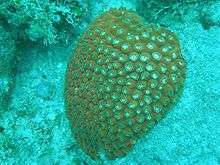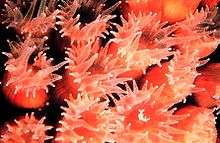Montastraea
Montastraea is a genus of colonial stony coral found in the Caribbean seas. It is the only genus in the monotypic family Montastraeidae. One common species, Montastraea cavernosa, is known as great star coral. It forms into massive boulders and sometimes develops into plates. Its polyps are the size of a human thumb and fully extend at night.[1]
| Great star coral | |
|---|---|
 | |
| Scientific classification | |
| Kingdom: | Animalia |
| Phylum: | Cnidaria |
| Class: | Anthozoa |
| Order: | Scleractinia |
| Family: | Montastraeidae Yabe & Sugiyama, 1941 |
| Genus: | Montastraea Blainville, 1830 |
| Species: | M. cavernosa |
| Binomial name | |
| Montastraea cavernosa (Linnaeus, 1767) | |
| Synonyms | |
|
List (Genus)
(Species)
| |
Description

Great star coral colonies form massive boulders and domes over 5 feet (1.5 m) in diameter in waters of shallow and moderate depths. In deeper waters, this coral has been observed growing as a plate formation. It is found throughout most reef environments, and is the predominant coral at depths of 40–100 feet (12.2-30.5 m).
This coral occasionally has a fluorescent red or orange color during daytime; it has recently been suggested that this hue is due to phycoerythrin, a cyanobacterial protein. It appears that, in addition to symbiotic zooxanthella, this coral harbors endocellular symbiotic cyanobacteria, possibly to help it fix nitrogen. However more recently, Oswold et al. (2007) showed an absence of functional phycoerythrin in M. cavernosa.[2]
Dark brown, light brown, and white are typically the colors one sees when observing M. cavernosa in the wild. An interesting ecological finding published in 2015 by Marine Biology noted that when it came to the Coral bleaching of M. cavernosa, "conventional spectral reflectance techniques failed to discriminate white from bleached colonies." Upon completion of a more meticulous reef survey conducted at the Bay of All Saints, it was revealed that "the proportion of bleached and white colonies is similar, suggesting coral reefs surveys may be overestimating the bleaching of M. cavernosa by nearly two-fold." [3]
References
- "Common Corals of Florida". Archived from the original on 2008-05-27. Retrieved 2008-05-29.
- Oswald, Franz; Schmitt, Florian; Leutenegger, Alexandra; Ivanchenko, Sergey; D'Angelo, Cecilia; Salih, Anya; Maslakova, Svetlana; Bulina, Maria; Schirmbeck, Reinhold; Nienhaus, G. U.; Matz, Mikhail V.; Wiedenmann, Jörg (2007). "Contributions of host and symbiont pigments to the coloration of reef corals". FEBS Journal. 274 (4): 1102–1122. doi:10.1111/j.1742-4658.2007.05661.x. PMID 17244197.
- Cruz, Igor C. S.; Leal, Miguel C.; Mendes, Carlos R.; Kikuchi, Ruy K. P.; Rosa, Rui; Soares, Amadeu M. V. M.; Serôdio, João; Calado, Ricardo; Rocha, Rui J. M. (April 2015). "White but not bleached: photophysiological evidence from white Montastraea cavernosa reveals potential overestimation of coral bleaching". Marine Biology. 162 (4): 889–899. doi:10.1007/s00227-015-2633-9. ISSN 0025-3162.
